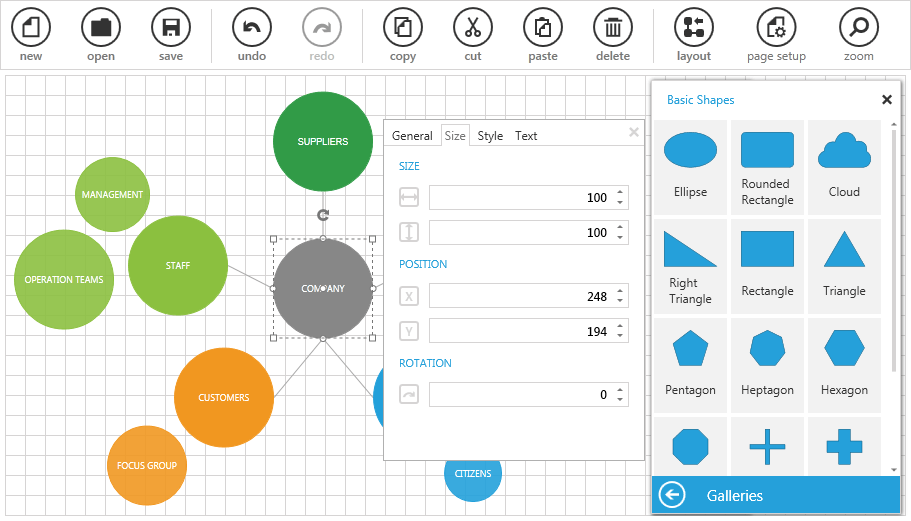WPF Diagram Overview
Thank you for choosing RadDiagram!
The RadDiagram control and its components allow you to create flexible and interactive diagramming layouts for your rich data-visualization application. The diagram toolset enables you to:
- Design workflows in which case shapes and connections are tightly bound to an underlying API.
- Simulate processes and represent data logic.
- Architect data-visualization and data analysis Diagramming structures.
- Further enhance and customize your geographic maps solutions.
The RadDiagram is part of Telerik UI for WPF, a
professional grade UI library with 160+ components for building modern and feature-rich applications. To try it out sign up for a free 30-day trial.

Key Features
Powerful data binding support: The diagramming framework supports data binding to objects and collections out-of-the-box. Read more about this in the Populating with Data section.
Extensive set of diagramming shapes: The diagramming framework exposes a set of predefined diagramming shapes. Read more about this in the Diagram Items section.
Flexible diagramming connections: The diagramming framework exposes flexible diagram connections. Read more about this in the Diagram Items section.
Items editing: The diagramming framework supports editing the content of the diagramming elements. Read more about this in the Items Editing article.
Items rotation: The diagramming framework supports rotation. Read more about this in the Rotation article.
Items resizing: The diagramming framework supports resizing. Read more about this in the Resizing artcle.
Items ZOrder: The diagramming framework supports changing the z-order of its elements. Read more about this in the ZOrder article.
Items selection: The diagramming framework allows users to select one or multiple diagram elements at any time. Read more about this in the Selection
Clipboard operations: The diagramming framework supports cut, copy and paste operations. Read more about this in the Clipboard Operations article.
Pan and zoom: The diagramming framework supports pan and zoom operations. Read more about this in the Pan and Zoom article.
Undo and redo: The diagramming framework supports undo and redo operations. Read more about this in the Undo and Redo article.
Align and Snap To Grid: The diagramming framework allows you to easily align the diagramming items_ and it also supports snap-to-grid operations. read more about this in the Align and Snap article.
Read-Only diagram: The diagramming framework allows you to create read-only diagramming structures but still keep the events and selections active thus allowing you to keep the interactivity of the solution. Read more about this in the Read-Only Diagram article.
Virtualization: The diagramming framework supports UI Virtualization, which collapses all items outside the viewable area, thus, enhancing additionally the UI performance while manipulating the diagramming elements. Read more about this in the Virtualization article.
Serialization: The diagramming framework supports serializing and deserializing Diagramming objects into and from XML documents. Read more about this in the Serialization article.
Mouse tools: The diagramming framework exposes a set of mouse tools - selection, connection and pan tools. Read more about this in the Mouse Tools article.
Shortcuts: The diagramming framework allows you to manipulate the diagramming elements using keyboard shortcuts. Read more about this in the Keyboard Support article.
Diagram commands: The diagramming framework expose a set of commands that allow you to easily implement RadDiagram interaction logic in MVVM solutions. Read more about this in the Commands article.
Services: The diagramming framework execute its actions via services which can be easily modified, thus allowing very extensive customization of the interaction with the diagramming surface. Read more about this in the Services article.
You can find all the general features of the diagram documented in the Features section.
Get started with the control with its Getting Started help article that shows how to use it in a basic scenario.
Check out the online demo at demos.telerik.com
Telerik UI for WPF Support and Learning Resources
- Telerik UI for WPF Diagrams Homepage
- Get Started with the Telerik UI for WPF Diagrams
- Telerik UI for WPF API Reference
- Getting Started with Telerik UI for WPF Components
- Telerik UI for WPF Virtual Classroom (Training Courses for Registered Users)
- Telerik UI for WPF Diagrams Forums
- Telerik UI for WPF Knowledge Base